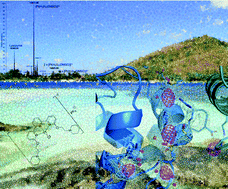A case of extensive protein platination: the reaction of lysozyme with a Pt(ii)–terpyridine complex†
Abstract
An antiproliferative platinum(II)–terpyridine complex bearing two piperidine substituents at positions 2 and 2′ (compound 1, hereafter) interacts non-covalently with DNA and induces cell death through necrosis, i.e. a mode of action that is distinct from that exhibited by cisplatin (Suntharalingam, et al., Metallomics, 2013, 5, 514). Here, the interaction between this Pt compound and the model protein hen egg white lysozyme (HEWL) was studied by both electrospray ionization mass spectrometry (ESI MS) and X-ray crystallography. The ESI MS data collected after 24 h protein incubation with compound 1 at two different pH values offer evidence that the metal complex degrades upon reaction with HEWL, forming adducts with 1 : 1, 2 : 1 and 3 : 1 Pt/protein ratios. Two different X-ray structures of Pt–protein adducts, obtained by the reaction of HEWL with the Pt compound under different experimental conditions and incubation times, are then reported. An unexpected extensive platination of the protein is clearly observed: Pt containing fragments bind close to the NZ atom of Lys1 and OE1 atom of Glu7, NE2 atom of His15 and NH1 atom of Arg14, ND1 atom of His15, NZ atom of Lys96, NZ atom of Lys97 and ND1 atom of Asn93, NZ atom of Lys13 and the C-terminal carboxylate, and the N-terminal amine. An additional binding site was observed close to the NZ atom of Lys33. These results suggest that both N- and C-terminal tails, as well as Lys side chains, have to be considered as potential binding sites of Pt-containing drugs. The peculiar reactivity of compound 1 with biological macromolecules could play a role in its mode of action.



 Please wait while we load your content...
Please wait while we load your content...